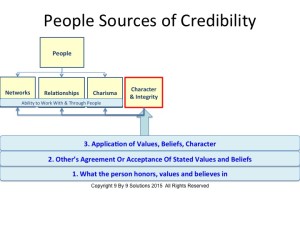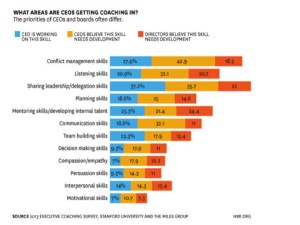Leadership is in disrepute and the situation is getting worse. It is the purpose of this four-part series to explore the sources of credibility that provide leaders the right to lead. The complete credibility model will be presented in part four.
Part 1 of this series addressed the fundamental core from which credibility arises – a person’s character. Character impacts and permeates all other aspects of credibility and provides the genuineness that makes all other sources of credibility meaningful. Character alone, however, is not sufficient to sustain leadership over a long period of time. Conversely, without character the leader’s true nature and flaws are eventually uncovered and credibility and the right to lead will be lost. If you missed part 1, it is housed at: https://9by9solutions.com/2015/10/where-does-the-credibility-to-lead-come-from-part-1-the-foundation-of-credibility/
Besides character, credibility resides in two other areas both of which are equally important. The first, which is the focus of this post, is “personal” credibility. Like character, personal sources of credibility are unique to the individual and are not directly tied to his or her professional role. These attributes will transfer with the person from job to job, career to career. The second major area, which will be the topic of part 3, is the productivity or performance source of credibility that is directly related to a person’s job performance.
I. What Is Personal Credibility?
Personal credibility comes from the individual. It is as unique as the individual is. This source of credibility arise out of an individual’s core beliefs about people: a core philosophy that believes that people will work hard, can and will contribute significant results and will innovate to find ways to superior solutions. This is a genuine belief that permeates the way the leader treats and collaborates with others. It is a value that believes that helping others to achieve their maximum potential is critical to both individual and organizational success. When others see this genuine belief lived out in actions they are drawn to the person and credibility is established.
Some people have natural significant strengths in this area. Other individuals work hard to learn skills and techniques in this area. This is why character is critical as the driver of people skills. The genuineness of the belief or philosophy behind these skills and techniques is essential since people sense when behavior is contrived or feigned to achieve other purposes.
For most leaders personal credibility is critical. (A few unique leaders might be able to be credible while playing the brilliant tyrant role; think Steve Jobs or Admiral Rickover. For most of us mere mortals, this approach does not work and personal sources of credibility are critical for success.
II. The Three Sources of “Personal” Credibility
There are three sources of personal credibility. They are charisma (both external and internal), relationship building and networking. All of these sources of credibility involve people. The three underlying credibility questions (see the diagram above) that were discussed in part 1 of this series apply to personal credibility. They explain why credibilty is in the eye of the beholder and no leader will never have credibility with every person they encounter.
A. Charisma
Charisma is attraction. It is defined as the ability to charm, draw or attract others although that definition is somewhat limited in its scope when it applies to credibility. When most people think of charisma, they often think about an external attraction: how a person looks; how a person dresses; the stature and demeanor of a person; or even a person’s ability to persuasively communicate and move people with their words. While these are definitely aspects of charisma, they are not the deeper drivers of credibility. To fully understand charisma as a source of credibility, one must consider both external charisma and internal charisma.
1. External charisma
Some people possess an aura and presence of leadership and credibility. When they walk into a room they command attention. This presence may come from height, their bearing or tone of voice, their ability to communicate, or simply an appearance of authority and power. While these characteristics form an initial basis of credibility, they are usually short-lived unless other sources of credibility are present also. I am reminded of a graduate of a military academy. When he walked into a room, people were impressed with his presence and demeanor. His bearing exuded leadership. He used all the right buzzwords to describe an issue and on first blush he impressed others that he knew exactly how to define and address a situation. After a short while one began to realize substance was lacking, and thinking was shallow. As a result his façade of credibility began to deteriorate over time as more people recognized this. At one point one of his colleagues wondered how, with this type of military officer, the US ever won any wars!
Externals tend to be superficial but that does not mean they are not effective and even desirable. External charisma adds an instant dimension of professionalism and respect like no other area can. They create an initial demeanor of credibility. While looking and acting the part is important, this kind of charisma cannot, on its own, sustain credibility.
2. Internal Charisma
People are also attracted to others because of who they are and not just the outward appearance. If one considers charisma from an internal perspective, several significant “personal” drivers of credibility become apparent. They are emotional intelligence, positivity and solution oriented.
2.a. Emotional Intelligence Credibility
Emotional intelligence is usually not thought about in terms of credibility. However, the ability to read a situation, to assess what the situation calls for and to do the right thing or avoid doing the wrong thing demonstrates a person’s ability to navigate various situations. Similarly the ability to advise others in ambigious situations is equally valuable and builds confidence and credibility in the leader.
Emotional intelligence also includes the ability to assess how to treat people differently depending on their needs while still practicing and holding true to principles of leadership that apply to everyone. This means not only doing the right thing but also doing it in a way in which a person will listen and respond. This deepens the respect and credibility of an individual.
Emotional intelligence is often slower to be noticed and sometimes is not considered valuable until a situation is ambiguous or high-risk but it is a strong source of credibility. Many leaders fail to gain credibility (or lose it) because they do the right thing but do it in the wrong way.
2.b. Positive Approach Credibility
A second source of internal charisma credibility comes from being positive. People are not attracted to negativity and a negative person seldom becomes an effective leader. This area is not optimism because credibility does not arise from being unrealistically optimistic. It arises from being realistically positive. It delivers a positive approach as to how things can be done while seeing clearly the barriers and problems to achieving the task. Being positive is at the heart of teamwork and it is often why this person will be selected to be part of a group or project. One of the major contributions of being positive is that it produces honest communication but not in a negative or destructive manner. Rather being positive focuses on addressing the core issues in a way to help individuals, teams or projects grow, improve and achieve results. This is a highly desirable trait at least in most healthy organizations.
2.c. Solution Oriented Credibility
The third area of internal charisma comes from being solution oriented. A person earns credibility by helping people and groups to perform at a higher level than they would have otherwise. Credibility stems from producing superior solutions rather than accepting mediocre and average ones just to finish the task.
Solution credibility involves a systematic thinking and questioning process that causes individuals and groups to go through a thinking process focused on what is possible. It pushes the envelope. It involves the facilitation and integration of the thinking of others but it is not doing their thinking for them. (This is a core skill to help others grow and develop. It is decision-making skills but with a significant twist: there is a strong emphasis on including and integrating others’ thinking into the process.)
Being solution oriented integrates different points of view (even when there is conflict over alternatives), while building involvement and commitment around a rationale evaluation of those alternatives. As a result, others are attracted to this person since their thinking is enhancing and coalitions are built around optimal approaches. While this type of thinking and facilitation can be learned, the attitude and art that values people’s contributions to create optimal solutions either exists or it does not.
B. Relationship Credibility
A former president of American Management Association said, “The ability to work with and through people is worth its weight in gold. “ To be an effective leader requires others to willingly follow rather than to be controlled. Relationships are at the heart of leadership and at the heart of credibility. The credibility to create that willingness is truly worth its weight in gold.
Relationship credibility involves depth of relationships. It is created one person at a time. Credibility is established by how one respects and treats others; by effectively working with others to make them successful; by helping and developing others; by treating individuals fairly and not “playing favorites”. People are attracted to those who genuinely see potential in them and who work with them to help them reach that potential. An attitude of humility underlies these relationships.
Every existing leader is a member of two teams. A leader’s credibility is enhanced when senior leadership sees that the leader has strong relationships with the team he or she leads. Conversely the leader’s credibility is enhanced when his or her team sees that their leader has credibility and can influence the leaders above him or her. Building simultaneous relationships with both these teams is the litmus test for credibility.
Unfortunately relationship credibility is not as common as it should be.. Dale Carnegie and MSW Research report, “The number one factor cited influencing disengagement of employees is the relationship with immediate supervisor.” The Center for Creative Leadership reports “that 82% of newly appointed leaders who derail fail because they do not build partnerships with subordinates and peers”. Parade Magazine reports “35% of U.S. workers would forgo a substantial pay raise in exchange for seeing their direct supervisor fired.”
To consider how important building relationships is to the credibility of a leader consider the chart below from Zenger-Folkman. 6 of the 16 areas deal with relationship failures and if one adds charisma and character failures the percentage rises to 50% due to credibility issues.
To further illustrate how important relationships are, consider the areas in which CEOs receive coaching to enhance their skills and credibility (Stanford University and the Miles Group). 83% of the areas listed involve relationship credibility areas.
C. Network Credibility
Building and sustaining relationships is important since this is often the oil that greases the wheel so that work gets done across the organizational hierarchy. A person’s credibility is enhanced when one can access and work with different people or groups to to build synergistic high value solutions between those parties.
Networking addresses the breath of a person’s relationships. Effective leaders do not work in a vacuum or even just with their team. They must interact with other teams or groups to gain information, resources and support. Some leaders are isolationists. They protect of their own turf and fail to build strong networks. Some despise networking as politics or “playing the game.” This view minimizes the credibility of having broad relationships (across the organization and with customers) and limits that person’s credibility.
Having a personal network is not sufficient by itself to earn credibility. Being willing to use one’s network to maximize efforts and achieve results earns credibility and establishes a person in their leadership role. The credibility that broad relationships creates is realized when a person is able to put individuals in contact with others who can provide guidance, support or resources and help make things happen. Networks also build a foundation for collaborative partnerships that become critical when cross-functional projects or decisions must occur. Thus credibility is earned through the development of a meaningful network.
This area is so important that many people develop a networking plan to determine whom they need to include in their network. Their goal is to add new and significant contacts to their network each year.
A Final Note About Personal Sources Of Credibility
There is much written about authenticity in leadership. That authenticity comes from character and a consistent leadership philosophy that drive the behaviors producing credibility. In no area is authenticity more important than in building personal relationship with those whom the leader works and leads.
One begins to see how one source of credibility is not sufficient to lead others. Personal credibility is important but credibility created solely on external factors will not last. Eventually time and crises will uncover the insincerity of the leader. Credibility of the leader becomes stronger as multiple significant sources of credibility are developed driven by strong character traits and a strong philosophy.
Copyright 9 By 9 Solutions. All Rights Reserved



